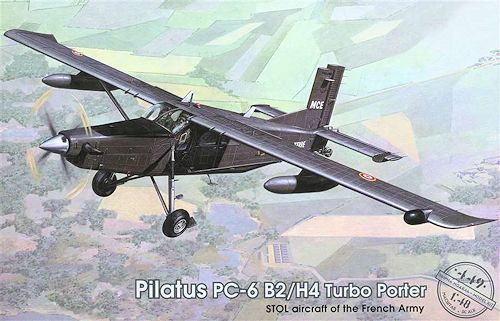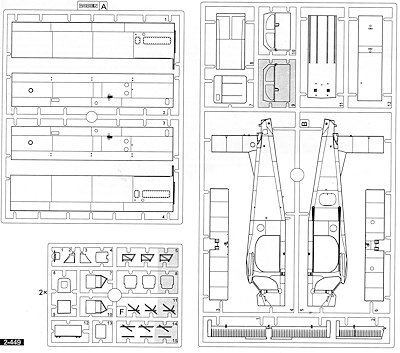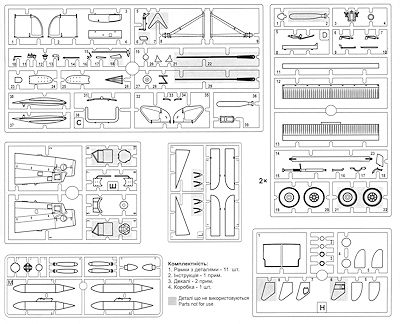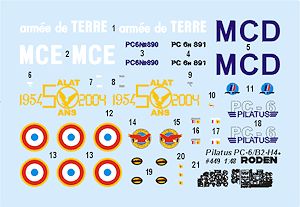
Roden 1/48 Pilatus PC-6B-2/H-4 Turbo Porter
| KIT #: | 449 |
| PRICE: | $52.99 MSRP |
| DECALS: | Two options |
| REVIEWER: | Scott Van Aken |
| NOTES: |

| HISTORY |
In 1959 the Swiss aircraft manufacturing company Pilatus created the PC-6 Porter, a lightweight multi-purpose single-engine plane with a 340 hp Lycoming GSO-480 engine. The plane was only built in small numbers (72), but despite its apparent simplicity its design showed great potential for a variety of applications. Two years later appeared the PC-6/A Turbo Porter with a 520 hp Turbomeca Astazou turboprop engine which improved on its predecessor in every important respect. Later another engine was installed in the plane, the 550 hp Pratt & Whitney Canada PT6A. On both sides of the fuselage in this 'B' version, as well as sliding doors on each side, there were individual pilot's doors. As in the PC-6A the nose was straightened with an elongated shape in cross section. In the PC-6/B2-H2 modification a 680 horsepower engine was installed, which improved the capability of the aircraft even more.
The latest and most modern variant of the type is the PC-6/B2-H4, the main
visual difference of which is the four blade airscrew, redesigned wingtips and
also a more powerful engine. An additional option is the facility to install
radar under the wing. Significant numbers of the PC-6/B2-H4 are still operated
by the Air Forces of France, Switzerland, Austria, Brazil and other countries
today. Their main task is to patrol highland or coastal areas where the
topography is very rough. The ability of the PC-6 to set down and take to the
air from sites poorly adapted for the purpose leaves it an uncontested choice
for the Air Forces of those countries where such machines are a mandatory
requirement for military service.
The turboprop PC-6 became popular very quickly among pilots, and the plane
started being exported beyond the borders of Switzerland to many countries in
different continents of the world. Nearly half a century after its debut flight
the PC-6 is in military and civil service in many parts of the planet, being in
good company with such renowned aircraft as the Piper Cub and the Antonov An-2,
proving that sometimes an unassuming and seemingly simple design can outlast
many of its more modern and more advanced 'colleagues'.
| THE KIT |
 This has to be
the fifth or sixth boxing of this aircraft, showing that Roden picked a good one
when it decided to kit the PC-6. This kit has quite a few of the same sprues
from the earlier kits, changing only those bits that are specific to the H-4
variant.
This has to be
the fifth or sixth boxing of this aircraft, showing that Roden picked a good one
when it decided to kit the PC-6. This kit has quite a few of the same sprues
from the earlier kits, changing only those bits that are specific to the H-4
variant.
Molded in grey
plastic, there are nine total sprues, all of them with very nice surface
detailing. Two of them are duplicated (the one with the seats and the one with
the wheels) and one is clear. I found no real problem with flash, though there
are a couple of sink areas
on the ones that are really thick. Anything of any size had ejector
pin marks or towers on one side. This means that a few parts (like the doors)
will need some additional attention.

The cockpit and cabin areas are nicely detailed with the cockpit being well appointed with seats that are different from previous boxings, control sticks, rudder pedals and so on. The cabin has a number of the more open seats that are similar to previous kits. This particular version does not have a sliding door on both sides, so on the left there are two hinged doors that open outwards from the center. These parts were on the previous kit but not to be used. There are separate elevators, ailerons and flaps. However, these are to be constructed in the neutral position otherwise the various actuating rods won't fit. There is a separate lower fuselage section on which the landing gear will be attached. Not sure why this wasn't part of the fuselage halves, but there you have it. Of course, the engine assembly is separate to the rest of the airframe and is to be attached near the end of construction.
What's new in this kit are two sprues. One of them has the two piece wing tips and the new, larger fin fillet. The other one houses the new four blade prop and spinner. It also contains under wing fuel tanks and what I'll guess is a radar pod as shown on the box art.
Instructions
are well done with color references in FS 595, Testors Acrylic and Testors
Model Master references. The instructions also have two diagrams to show where
to drill various holes for the
 antennas and
such. None of these holes are started so the measurements are quite exact as to
placement. When I built the AU-23, I copied the diagram to size and placed it on
the fuselage top, drilling through the areas marked. It worked very well.
Markings are provided for two French planes. The box art plane in overall OD
carries the fin marks for the 50th anniversary of ALAT or French Army aviation.
The other is in white with blue trim (which will need to be painted). This one
of the instruction glitches in that it does not identify the color. However I
found an image of t
antennas and
such. None of these holes are started so the measurements are quite exact as to
placement. When I built the AU-23, I copied the diagram to size and placed it on
the fuselage top, drilling through the areas marked. It worked very well.
Markings are provided for two French planes. The box art plane in overall OD
carries the fin marks for the 50th anniversary of ALAT or French Army aviation.
The other is in white with blue trim (which will need to be painted). This one
of the instruction glitches in that it does not identify the color. However I
found an image of t his
plane and here it is. Apparently it has been sold as a 2010 photo shows it with
the military insignia and designation crossed out and a French civil
registration on it. Another glitch I found is that it did not tell you to build
the larger fin filled nor did it say that you'll need to cut the old one off to
install it. The decal sheet is nicely printed and includes an instrument panel
decal.
his
plane and here it is. Apparently it has been sold as a 2010 photo shows it with
the military insignia and designation crossed out and a French civil
registration on it. Another glitch I found is that it did not tell you to build
the larger fin filled nor did it say that you'll need to cut the old one off to
install it. The decal sheet is nicely printed and includes an instrument panel
decal.
| CONCLUSIONS |
I like that Roden has decided to do this series. I can see that there are several more boxings that can be done as the PC-6 was quite a popular aircraft. The AU-23 I built required careful construction, but turned out quite well. I'm' sure this one will be the same.
| REFERENCES |
November 2013
Thanks to Squadron Products for the preview kit. Get yours at this link.
If you would like your product reviewed fairly and quickly, please contact me or see other details in the Note to Contributors.